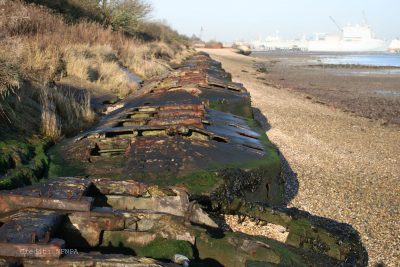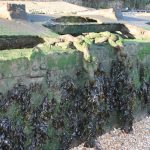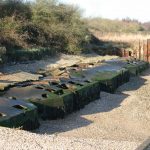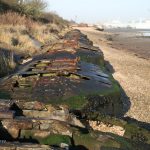Surviving Mulberry Beetles
During the planning for the assault phase of the invasion of Europe (D Day), it became clear that the early use of a major port (or preferably ports) would be crucial to ensure the reliable supply of troops and materiel critical to making the invasion a success. This presented a number of challenges, among which were the likely heavy casualty rates in attacking a port directly (as demonstrated at Dieppe in 1942), and the risk that the port would be rendered inoperable before capture by enemy action or the attack itself. It was therefore decided that two artificial harbours (codenamed ‘Mulberry’) would be constructed and then towed across the English Channel to Normandy, almost literally in the wake of the invading forces, to be assembled at beaches Omaha and Gold.
The Mulberry Harbours consisted of a number of elements, each of which was crucial to the functioning of the whole. These can be broadly categorised into two groups:
- Breakwaters used to create a sheltered area in which ships could load and offload. These consisted of blockships (‘Corncob’), concrete caissons (‘Phoenix’) and floating steel barriers (‘Bombardons’);
- Floating pierheads and roadways (‘Whales’), which by falling and rising with the tide facilitated the two-way movement of troops and materiel from the ships to the shore. The roadways were supported by floating pontoons made of steel or reinforced concrete (‘Beetles’).
Elements of these Mulberry Harbours were built at various points along the New Forest coast; at Stone Point (Lepe), along the Beaulieu River and at Marchwood Military Port including Whales and Beetles.
39 Beetles constructed at Marchwood Military Port still survive today and lie along the foreshore between Hythe and Marchwood. These units were surplus to requirement and were not towed over to the Normanday Beaches, but were recycled firstly as breakwaters and then as coastal defence to protect reclamation areas.
For more information on the site a recent report on the Beetles by masters’ students at the University of Southampton can be downloaded here
You can find out more about the New Forest’s vital role in D-Day from Mulberry Harbour, to holding camps, road widening, advanced landing grounds, PLUTO and Embarkation by visiting our main page on D-Day in the New Forest.






